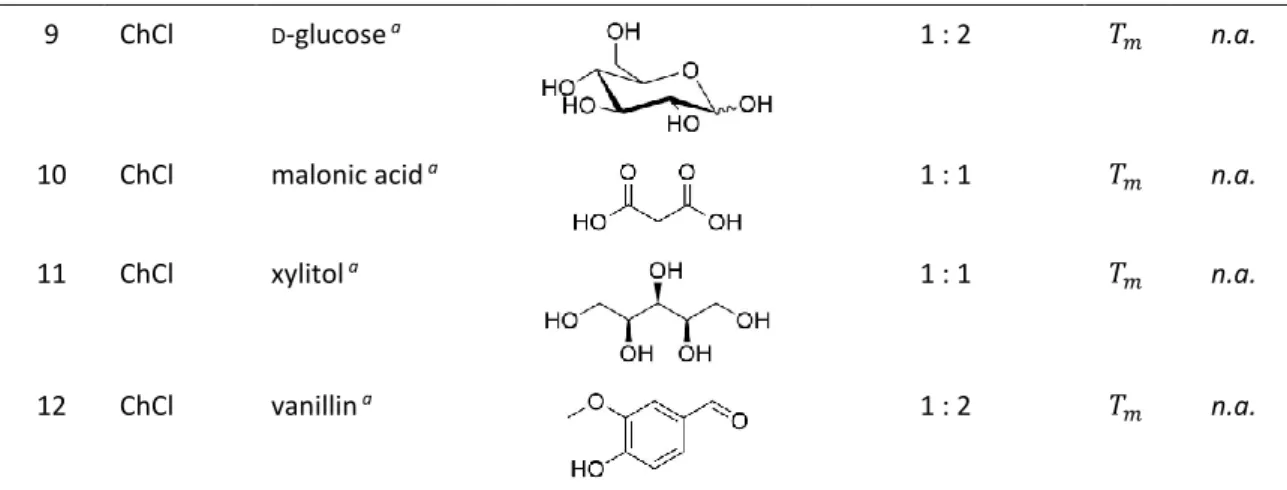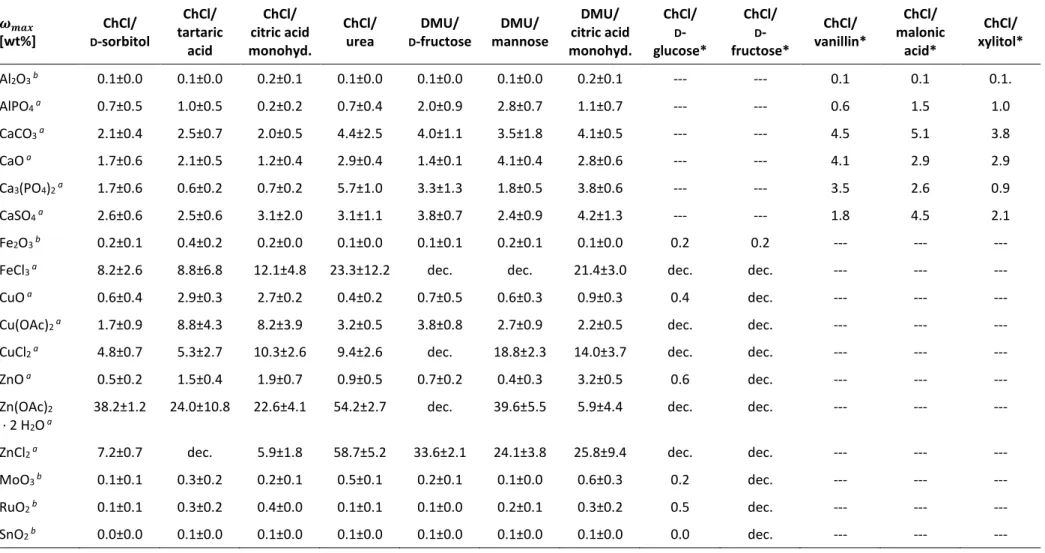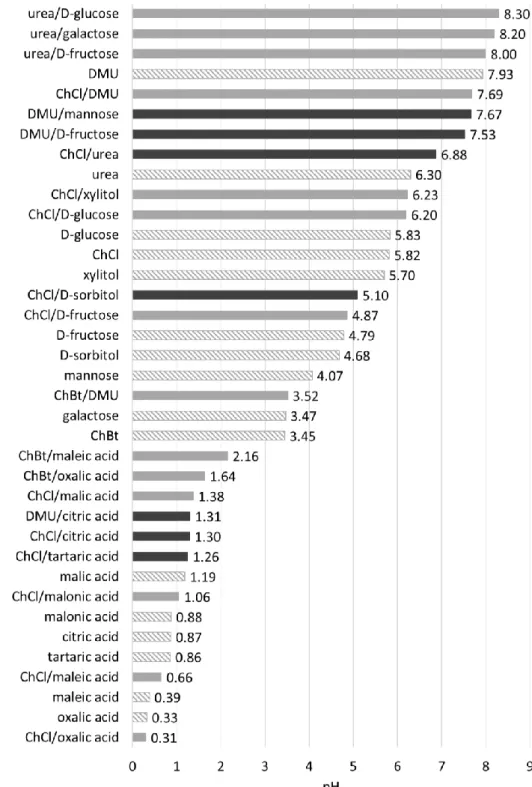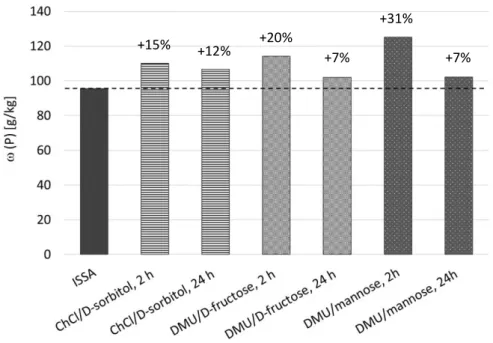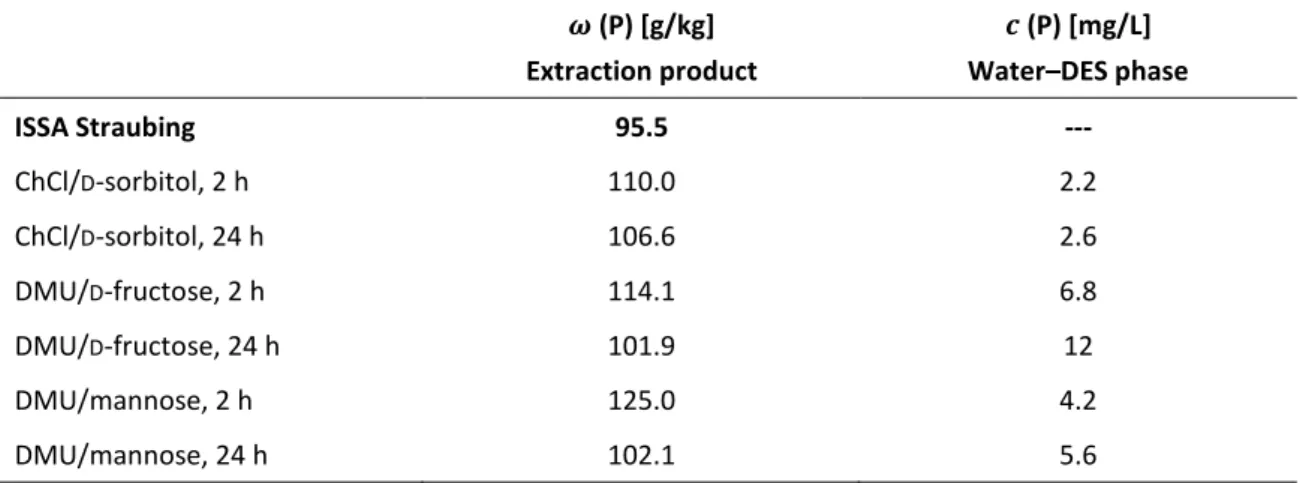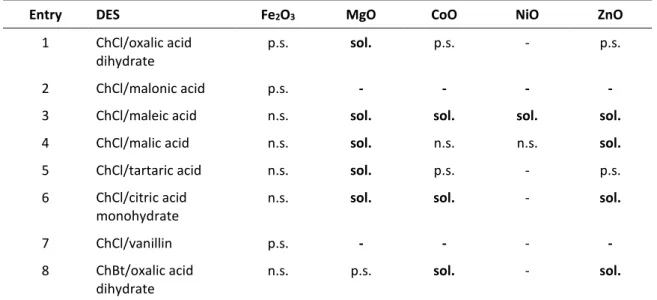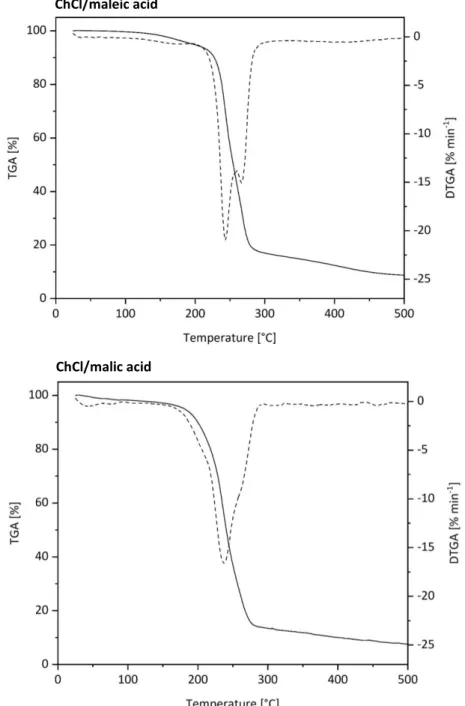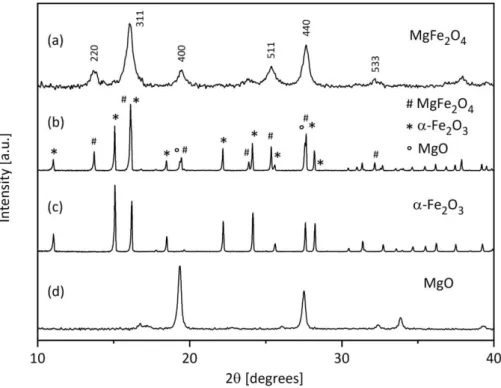Deep Eutectic Solvents
as Extraction, Reaction and Detection Media for Inorganic Compounds
Dissertation
Zur Erlangung des Doktorgrades der Naturwissenschaften (Dr. rer. nat.)
an der Fakultät für Chemie und Pharmazie der Universität Regensburg
vorgelegt von
Anika Söldner
(geb. Kolb) aus Pegnitz
2019
This work has been carried out between December 2013 and April 2019 under the supervision of Prof. Dr. Burkhard König at the University of Regensburg, Institute of Organic Chemistry.
Date of submission: 04.04.2019 Date of colloquium: 10.05.2019
Board of examiners: Prof. Dr. Alexander Breder (chair)
Prof. Dr. Burkhard König (1
streferee)
Prof. Dr. Arno Pfitzner (2
ndreferee)
Prof. Dr. Frank-Michael Matysik (examiner)
"A philosopher once said: 'It is necessary for the very existence of science that the same conditions always produce the same results'. – Well… they do not."
Richard P. Feynman
(Nobel Prize in Physics in 1965)T ABLE OF C ONTENTS
1 D EEP E UTECTIC S OLVENTS AS E XTRACTION M EDIA FOR P HOSPHATES FROM
I NCINERATED S EWAGE S LUDGE A SH ... 1
1.1 Introduction ... 3
1.2 Results and Discussion ... 5
1.2.1 Solubility of Metal Salts and Metal Oxides in Different DESs ... 5
1.2.2 Extraction of Phosphorus from ISSA with DESs ... 15
1.3 Conclusion ... 20
1.4 Experimental ... 21
1.4.1 General Procedures and Materials ... 21
1.4.2 Procedures and Analytical Methods for Solubility Experiments ... 22
1.4.3 Procedures and Analytical Methods for the Extraction of Phosphates from ISSA ... 23
1.5 References ... 24
2 P REPARATION OF M AGNESIUM , C OBALT AND N ICKEL F ERRITE N ANOPARTICLES FROM M ETAL O XIDES USING D EEP E UTECTIC S OLVENTS ... 29
2.1 Introduction ... 31
2.2 Results and Discussion ... 32
2.2.1 Dissolving Properties and Incineration Behavior of DESs ... 32
2.2.2 Synthesis of Different Spinel-Type Ferrites with DESs ... 36
2.2.3 Characterization of the Synthesized Ferrite Nanoparticles ... 44
2.3 Conclusion ... 46
2.4 Experimental ... 46
2.4.1 General Procedures and Materials ... 46
2.4.2 Thermal Process for the Synthesis of Spinel-Type Ferrites with DESs .. 47
2.4.3 Characterization Methods ... 47
2.5 References ... 49
3 D EEP E UTECTIC S OLVENTS AS P OTENTIAL M EDIA FOR O PTICAL A NALYSIS AND
S EPARATION OF T RIVALENT L ANTHANIDES ... 53
3.1 Introduction ... 55
3.2 Results and Discussion ... 58
3.2.1 Spectroscopic Studies of Trivalent Lanthanides in DESs ... 60
Europium(III) ... 61
Terbium(III) ... 71
Further Trivalent Lanthanides (Sm
3+, Dy
3+) ... 73
3.2.2 Solubility and Separation Experiments of Trivalent Lanthanide Oxides in DESs ... 73
3.3 Conclusion ... 79
3.4 Experimental ... 79
3.4.1 General Procedures and Materials ... 79
3.4.2 Spectroscopic Methods for Luminescence Studies ... 80
3.4.3 Procedures and Analytical Methods for Solubility and Separation Experiments ... 80
3.5 References ... 82
4 S UMMARY ... 89
5 Z USAMMENFASSUNG ... 93
6 A PPENDIX ... 97
6.1 References for Renewable DES Compounds ... 97
6.2 Degree of Inversion of the Prepared MgFe
2O
4Nanoparticles ... 97
6.3 Concentration Dependence of the Fluorescence Intensity ... 99
6.4 Fluorescence Spectra of Samarium(III) and Dysprosium(III) Chlorides in DESs ... 103
6.5 Abbreviations ... 105
7 D ANKSAGUNG ...111
1
C HAPTER 1
1 Deep Eutectic Solvents as Extraction Media for Phosphates from Incinerated Sewage Sludge Ash
This chapter has been published as:
A. Söldner, J. Zach and B. König, Green Chem., 2019, 21, 321-328.
A. Söldner performed the solubility experiments, carried out all measurements and wrote the manuscript.
J. Zach accomplished the phosphorus extraction experiments. B. König supervised the project and is the
corresponding author.
2
3
1.1 Introduction
The extraction of phosphates from a nearly inexhaustible secondary resource using renewable solvents based on natural products would imply a great step towards sustainability. Besides phosphate rock as a primary but a limited source for phosphorus compounds, the main secondary but hardly used resource is sewage sludge, whose availability would be ensured for decades. The difficulties of sewage sludge workup are the complexity and inhomogeneity of its composition.
1While some batches of sewage sludge can be used as manure for agriculture, the bulk is combusted to incinerated sewage sludge ash (ISSA) or used as landfill.
2The incineration of sewage sludge has several advantages as it removes the relatively high water content, reduces the mass and volume by up to 90%, and concentrates the mineral fraction, which increases the processing capacities required.
3, 4In addition, pathogenic agents get destroyed, organic compounds are oxidized (e.g. residues of pharmaceuticals and personal care products),
5-8and thermal energy is generated that can be used.
9-11Due to the fact that all modern agricultural systems depend on the continual application of phosphate fertilizers
12and the predicted phosphorus scarcity by the end of this century,
13-15it is crucial to find effective (and ideally environmentally friendly) extraction processes for phosphate compounds from renewable resources. Furthermore, the European Union (EU) has no natural mining sites of phosphate rock and is entirely dependent on imports. Therefore, the legal regulations in EU countries intensify. For example, in Germany, the new Ordinance for the Recovery of Sewage Sludge came into force on October 2, 2017, which bounds the operators of sewage sludge treatment plants for municipal districts with more than 50 000 citizens to the recovery of phosphorus from sewage sludge and ISSA by 2032 at the latest.
16, 17As a result, countries such as the United Kingdom, the Netherlands, Austria and Germany increasingly support research on the recovery of phosphates.
2, 18-20Several methods for achieving the goal have been reported, but so far, none of these
processes has become established as a standard for phosphate recycling for industry and
municipalities or offers a low-energy and environmentally friendly procedure under mild
4
extraction conditions, as far as we know. Recovery of phosphorus by acid leaching is one of the extensively studied approaches. A major challenge is the separation or precipitation of metals that are also soluble in the respective acidic solution. Several acids were investigated: H
2SO
4,
21-26H
3PO
4,
27, 28HCl,
22, 24, 29-31HNO
3,
27, 28, 32citric acid and oxalic acid.
22For many of these processes, high amounts of acids are required and the amount of wet solid residues for disposal is higher than the amount of ISSA that was treated. One process tested at a large scale is the REMONDIS TetraPhos procedure, which has phosphoric acid and gypsum as its final products.
33The main alternative for P recovery so far is via thermal methods below or above the melting point of ISSA at around 1300 °C dependent on the composition. Thermochemical treatment at 900–1000 °C and the addition of nutrients nitrogen, phosphorus, and potassium or chlorinating agents (e.g. Cl
2, MgCl
2, KCl
2, CaCl
2, and NaCl
2) to ISSA lead to a high percentage removal of undesirable compounds by volatilization,
34-36but also 30% of P can be lost in fine ashes carried out with exhaust gases.
24The P-recovery process developed within the framework of the European FP6-project SUSAN is based on this procedure and has already been tested on an industrial scale.
37At temperatures above 1450 °C, phosphorus can be transferred into a metallurgical slag by reductive smelting
38or reduced to elementary phosphorus and separated via the gas phase.
39However, both types of thermochemical processes are accompanied by high energy costs and the necessity of an appropriate composition of ISSA. Furthermore, less intensively studied methods are using base
29or supercritical fluids
40as an extractant or electrodialytic separation in acids.
41, 42One class of extractants that has not been considered so far is ionic liquids (ILs) and
deep eutectic solvents (DESs). An IL is a salt in the liquid state, whereas DESs consist of a
hydrogen-bond acceptor (HBA) and a hydrogen-bond donor (HBD) forming a mixture with
a melting point that is significantly lower than that of the two single components – ideally
around room temperature.
43, 44DESs share many properties with ILs but, in addition, DESs
are facile to prepare, based on readily available and inexpensive starting materials, and
do not accumulate in the environment. Both types of liquids have previously been
reported as extraction media for a variety of compounds from complex matrices. DESs
and ILs provide a high solvation potential without the presence of water, an organic
5 solvent, or the highly basic/acidic conditions that are needed in most analogous aqueous systems. This is exemplified by the extraction of metals from different waste streams including slag, filter cakes and battery waste,
45-47natural products from plant materials,
48-52
and lipids from primary sewage sludge.
53In this chapter, we present a comprehensive study of the extraction potential of DESs based on natural products for a variety of metal salts and metal oxides, as well as a new approach for phosphorus mineral extraction from ISSA.
1.2 Results and Discussion
In many papers and reviews, DESs and ILs are discussed as solvents that are fully adjustable to many requirements and separation problems due to the wide variety of composition possibilities. However, the prediction of e.g. specific extraction properties is still a challenge. Furthermore, DESs and ILs have poor transport properties compared to molecular solvents such as water. They are at least an order of magnitude more viscous than molecular solvents, which leads to slow transport of the diffusing species and complicated handling. Nonetheless, DESs and ILs provide a high solvation potential even for hardly soluble metal oxides under relatively mild conditions.
1.2.1 Solubility of Metal Salts and Metal Oxides in Different DESs
In the first part of this report, we discuss the solvation potential of 12 different DESs with respect to metal salts and metal oxides. The used metal compounds are either main or valuable trace components of ISSA or at least of interest regarding prior workup.
1As HBA components for the DESs choline chloride (ChCl) and N,N′-dimethyl urea (DMU) were used (Figure 1). Both compounds form low viscosity melts with a variety of HBDs at temperatures up to 100 °C in a viscosity range of 20 to 750 cP, which is crucial for further extraction experiments.
54, 55Figure 1. Hydrogen-bond acceptors (HBAs) for DESs used as extraction media: choline chloride (ChCl, left)
and N,N′-dimethyl urea (DMU, right).
6
The HBD component of the DESs varies from sugars and sugar alcohols to organic acids and urea (Table 1). The majority of the compounds for the presented DESs are easily available and inexpensive as well as readily biodegradable and renewable (for detailed references on the renewability of the used DES compounds see Table A.1 in Appendix 6.1).
56, 57For each metal salt and oxide, an oversaturated mixture was prepared with the DESs at a processing temperature of 80 or 90 °C (Table 1), which was chosen according to the following aspects: high enough to ensure low viscosity and maximum solubility due to heat exposure; low enough to avoid decomposition, sublimation or vaporization of the DES components and easy handling.
Table 1. DESs 1–12 based on choline chloride (ChCl) or N,N′-dimethyl urea (DMU) as hydrogen-bond acceptor (HBA) with sugars, sugar alcohols, organic acids, urea and vanillin as hydrogen bond donor (HBD), and the respective melting point (𝑇
𝑚) or solidification point (𝑇
𝑠).
43, 58, 59Entry HBA HBD Structure
cMolar ratio
T [°C]1 ChCl
D-sorbitol
b1 : 1
𝑇𝑚liquid
at r.t.
2 ChCl tartaric acid
b2 : 1
𝑇𝑚47
3 ChCl citric acid monohydrate
a2 : 1
𝑇𝑠69
4 ChCl urea
a1 : 2
𝑇𝑠12
5 DMU
D-fructose
a3 : 1
𝑇𝑚80
6 DMU mannose
a5 : 1
𝑇𝑚75
7 DMU citric acid monohydrate
a7 : 2
𝑇𝑚65
8 ChCl
D-fructose
a1 : 2
𝑇𝑚 n.a.7
9 ChCl
D-glucose
a1 : 2
𝑇𝑚 n.a.10 ChCl malonic acid
a1 : 1
𝑇𝑚 n.a.11 ChCl xylitol
a1 : 1
𝑇𝑚 n.a.12 ChCl vanillin
a1 : 2
𝑇𝑚 n.a.Processing temperature: (a) 80 °C or (b) 90 °C. (c) Structures do not contain hydrate molecules.
Abbreviation: n.a. = not available.
The appearance of the obtained samples ranged from slightly turbid for colloidal solutions or suspensions to completely clear, indicating that the metal compound was largely dissolved (Figure 2).
Figure 2. Turbid and clear saturated solutions of a) CuCl
2in ChCl/citric acid monohyd. (turbid, left) and DMU/citric acid monohyd. (clear, right), b) CuO in ChCl/
D-sorbitol (turbid, left) and ChCl/citric acid monohyd.
(clear, right), c) ZnO in ChCl/
D-sorbitol (turbid, left) and ChCl/citric acid monohyd. (clear, right), and d) MoO
3in ChCl/
D-mannose (turbid, left) and ChCl/citric acid monohyd. (clear, right) after hot filtration.
The amount of the dissolved metal in the DESs was determined via inductively
coupled plasma optical emission spectroscopy (ICP-OES) (inductively coupled plasma
optical emission spectroscopy) or reweighing after the complete combustion of the
organic components. The obtained values for the mass fraction 𝜔
𝑚𝑎𝑥of the maximum
dissolved metal salt or oxide are listed in Table 2 for DESs 1–12 and are depicted in Figure
3, Figure 4, Figure 5, and Figure 6 for DESs 1–7. The values for DESs 1–7 represent an
average of three independent measurements.
8
Figure 3. Maximum solubility as the mass fraction 𝜔
𝑚𝑎𝑥[wt%] of metal oxides in DESs 1–7.
Figure 4. Maximum solubility as the mass fraction 𝜔
𝑚𝑎𝑥[wt%] of metal chlorides in DESs 1–7.
9 Figure 5. Maximum solubility as the mass fraction 𝜔
𝑚𝑎𝑥[wt%] of metal acetates in DESs 1–7.
Figure 6. Maximum solubility as the mass fraction 𝜔
𝑚𝑎𝑥[wt%] of metal phosphates in DESs 1–7.
10
Table 2. Mass fraction 𝜔
𝑚𝑎𝑥[wt%] of 26 different metal salts and oxides in DESs 1–12.
𝝎𝒎𝒂𝒙
[wt%]
ChCl/
D
-sorbitol
ChCl/
tartaric acid
ChCl/
citric acid monohyd.
ChCl/
urea
DMU/
D
-fructose
DMU/
mannose
DMU/
citric acid monohyd.
ChCl/
D
- glucose*
ChCl/
D
- fructose*
ChCl/
vanillin*
ChCl/
malonic acid*
ChCl/
xylitol*
Al
2O
3 b0.1±0.0 0.1±0.0 0.2±0.1 0.1±0.0 0.1±0.0 0.1±0.0 0.2±0.1 --- --- 0.1 0.1 0.1.
AlPO
4 a0.7±0.5 1.0±0.5 0.2±0.2 0.7±0.4 2.0±0.9 2.8±0.7 1.1±0.7 --- --- 0.6 1.5 1.0
CaCO
3 a2.1±0.4 2.5±0.7 2.0±0.5 4.4±2.5 4.0±1.1 3.5±1.8 4.1±0.5 --- --- 4.5 5.1 3.8
CaO
a1.7±0.6 2.1±0.5 1.2±0.4 2.9±0.4 1.4±0.1 4.1±0.4 2.8±0.6 --- --- 4.1 2.9 2.9
Ca
3(PO
4)
2 a1.7±0.6 0.6±0.2 0.7±0.2 5.7±1.0 3.3±1.3 1.8±0.5 3.8±0.6 --- --- 3.5 2.6 0.9
CaSO
4 a2.6±0.6 2.5±0.6 3.1±2.0 3.1±1.1 3.8±0.7 2.4±0.9 4.2±1.3 --- --- 1.8 4.5 2.1
Fe
2O
3 b0.2±0.1 0.4±0.2 0.2±0.0 0.1±0.0 0.1±0.1 0.2±0.1 0.1±0.0 0.2 0.2 --- --- ---
FeCl
3 a8.2±2.6 8.8±6.8 12.1±4.8 23.3±12.2 dec. dec. 21.4±3.0 dec. dec. --- --- ---
CuO
a0.6±0.4 2.9±0.3 2.7±0.2 0.4±0.2 0.7±0.5 0.6±0.3 0.9±0.3 0.4 dec. --- --- ---
Cu(OAc)
2 a1.7±0.9 8.8±4.3 8.2±3.9 3.2±0.5 3.8±0.8 2.7±0.9 2.2±0.5 dec. dec. --- --- ---
CuCl
2 a4.8±0.7 5.3±2.7 10.3±2.6 9.4±2.6 dec. 18.8±2.3 14.0±3.7 dec. dec. --- --- ---
ZnO
a0.5±0.2 1.5±0.4 1.9±0.7 0.9±0.5 0.7±0.2 0.4±0.3 3.2±0.5 0.6 dec. --- --- ---
Zn(OAc)
2∙ 2 H
2O
a38.2±1.2 24.0±10.8 22.6±4.1 54.2±2.7 dec. 39.6±5.5 5.9±4.4 dec. dec. --- --- ---
ZnCl
2 a7.2±0.7 dec. 5.9±1.8 58.7±5.2 33.6±2.1 24.1±3.8 25.8±9.4 dec. dec. --- --- ---
MoO
3 b0.1±0.1 0.3±0.2 0.2±0.1 0.5±0.1 0.2±0.1 0.1±0.0 0.6±0.3 0.2 dec. --- --- ---
RuO
2 b0.1±0.1 0.3±0.2 0.4±0.0 0.1±0.1 0.1±0.0 0.2±0.1 0.3±0.2 0.5 dec. --- --- ---
SnO
2 b0.0±0.0 0.1±0.0 0.1±0.0 0.1±0.0 0.1±0.0 0.1±0.0 0.1±0.0 0.0 dec. --- --- ---
11 LaCl
3∙ 7 H
2O
a49.7±7.7 5.5±1.5 12.8±4.2 42±4.3 37.4±2.4 38.5±6.8 18.4±0.9 dec. dec. --- --- ---
CeO
2 b0.2±0.1 0.2±0.1 0.4±0.1 0.1±0.1 0.2±0.1 0.4±0.2 0.2±0.1 0.3 dec. --- --- ---
CeCl
3 a2.1±0.6 0.5±0.2 0.7±0.4 3.1±1.0 8.9±1.4 12.0±0.3 4.8±1.1 dec. dec. --- --- ---
EuCl
3 a1.8±0.8 2.6±2.1 0.4±0.3 1.8±0.5 1.8±0.9 3.3±1.3 2.4±1.9 0.8 dec. --- --- ---
PtO
2 b0.1±0.0 0.1±0.1 0.2±0.1 0.1±0.0 0.1±0.1 0.2±0.1 0.2±0.0 0.2 dec. --- --- ---
PbO
bdec. 0.2±0.2 0.2±0.1 0.4±0.3 dec. dec. 2.0±0.8 dec. dec. --- --- ---
PbO
2 bdec. 0.5±0.1 0.2±0.1 0.6±0.2 dec. dec. 1.9±0.4 dec. dec. --- --- ---
Pb(OAc)
2∙ 3 H
2O
a8.1±2.8 10.3±0.8 3.3±1.5 7.9±1.2 dec. dec. 1.5±0.3 dec. dec. --- --- ---
PbCl
2 a0.5±0.4 0.5±0.5 0.5±0.3 3.2±2.2 4.3±1.8 3.3±0.6 4.7±6.6 0.4 0.3 --- --- ---
Determination of metal contend in the filtered DES: (a) via ICP-OES of a solution with half-concentrated fuming nitric acid (10.7 M) or (b) via reweighing after complete
combustion of the organic components in a muffle furnace. Abbreviations: dec. = decomposition of the DES; --- = experiment was not performed; * = unpublished results.
12
If an entry is stated as dec., it indicates that the eutectic melt solidified or decomposed after the addition of the metal compound and the sample was unusable for further investigations.
The DESs are able to dissolve or at least highly disperse up to 50 wt% of some metal compounds. The low melting mixtures are even capable of processing up to 0.4 wt% of metal oxides (e.g. Al
2O
3and Fe
2O
3) that are hardly soluble in harsh acids. Furthermore, the solubility of a metal salt or oxide can vary depending on the DES by an order of magnitude (e.g. Ca
3(PO
4)
2, ZnCl
2, CuO, and CeCl
3). In particular, eutectic melts that contain urea or its derivative DMU show a high tendency to dissolve especially metal chlorides and phosphates compared to other DESs (Figure 4 and Figure 6). For acetates, melts with ChCl provide a preferable extraction medium (Figure 5), whereas carboxylic acids such as tartaric acid or citric acid as a melt component result in a DES with high potential to dissolve metal oxides (Figure 3). Hydrates show a significant increase in solubility that may be explained by the contained water of crystallization (Figure 4 and Figure 5). The corresponding metal salts of the herein used hydrates possess a high solubility in water.
By heating the hygroscopic DES mixture, water molecules are released, which may support the solvation of the metal salt in the eutectic melt.
To gain further insight into the properties of DESs used for extraction, the pH value was measured in aqueous solution (2 M) of DESs based on ChCl, choline bitartrate (ChBt), urea or DMU as HBA (Figure 7). The pH value of eutectic melts cannot be determined without the addition of water as the melts are completely anhydrous, which means that the actual pH conditions in DESs can only be approximated. For comparison, the pH values of the DESs from Table 1 and Table 3 as well as all related single components were determined under the same conditions. The values are depicted in Figure 8.
Figure 7. Hydrogen-bond acceptors (HBA) for DESs used as extraction media: choline chloride (ChCl) and
N,N′-dimethyl urea (DMU), and for further investigations of the pH value: choline bitartrate (ChBt) and urea(from left to right).
13 Table 3. DESs 13–22 based on choline chloride (ChCl), choline bitartrate (ChBt), urea or N,N′-dimethyl urea (DMU) as hydrogen-bond acceptor (HBA) with different hydrogen-bond donors (HBD) and the respective molar ratio [n:n].
43, 58, 59Entry HBA HBD Structure
aMolar ratio
13 ChCl maleic acid 1 : 1
14 ChCl malic acid 1 : 1
15 ChCl oxalic acid
dihydrate
1 : 1
16 ChBt DMU 1 : 2
17 ChBt maleic acid 1 : 1
18 ChBt oxalic acid
dihydrate
1 : 1
19 urea
D-fructose 4 : 1
20 urea
D-glucose 9 : 2
21 urea galactose 7 : 1
22 DMU ChCl 2 : 1
(a) Structures do not contain hydrate molecules.
14
Figure 8. pH values of herein used DESs (black), further eutectic melts (grey), and single components
(striped) for comparison; determined for 2 M solutions with water.
15 The low melting mixtures show pH values from acidic to basic, and the values do not necessarily correspond to the pH of the single components or their average. For example, the pH value of 2 M aqueous sugar solutions is in the range between 4 and 6 and for urea at 6.3, whereas the urea–sugar melts are weakly basic around pH 8. DESs containing an organic acid as an HBD are strongly acidic with a pH between 2 and 0, which explains why metal oxides are especially dissolved or incorporated by those melts. In accordance with the results for the pH values of eutectic mixtures favorable for metal chlorides, these compounds dissolve in neutral or slightly basic media. Also, phosphates tend to dissolve preferably in neutral to low basic DESs, although this finding does not correlate with the general behavior of AlPO
4and Ca
3(PO
4)
2.
The results of the solubility experiments provide the extraction selectivity characteristics that are essential for separation procedures. The data imply that an effective separation of different metal salts and metal oxides with DESs is possible. Furthermore, the selectivity can be partly correlated with the pH values of the DESs. The high variation of the determined values shows on the other hand that for each separation problem, the applicability of a DES as an extractant has to be tested separately and that the suitable eutectic solvent has to be adjusted empirically.
1.2.2 Extraction of Phosphorus from ISSA with DESs
ISSA is a particularly promising and at the same time challenging target for extraction investigations of phosphorus: phosphate-based compounds are embedded in a highly complex matrix with a wide variety of main and trace components with similar solubility properties in common solvents and extraction media. Furthermore, the amount of phosphorus can reach from 3 up to 15 wt% (≙ 30–150 g/kg dry matter) from batch to batch, which makes extensive investigations necessary.
In the following section, we present first promising results for the accumulation of
phosphorus from ISSA with a simple and low-energy extraction process using DESs as
extraction media. All measurements were performed following German DIN standards for
the characterization of sludge, soil, or water. This includes aqua regia digestion of all
samples and analysis by ICP-OES, inductively coupled plasma mass spectrometry (ICP-MS),
16
or atomic absorption spectrometry (AAS) depending on the concentration of the element in the sample.
The solubility behavior of the single main components (whitlockite Ca
3(PO
4)
2, aluminum phosphate AlPO
4, quicklime CaO, calcite CaCO
3, anhydrite CaSO
4, and hematite Fe
2O
3) and many possible trace metal salts and oxides of ISSA in DESs was already investigated in the first section. Referring to Figure 6, the investigated phosphates, whitlockite and aluminum phosphate, accumulate selectively in DESs that contain urea or its derivative DMU. Furthermore, the solvation of metal oxides, which constitute a large share of ISSA and are to separate from the phosphates, is preferred in acidic DESs.
Consequently, neutral to slightly basic DESs with a urea derivative as a component may provide suitable extraction conditions for whitlockite and aluminum phosphate. Based on the herein investigated DESs, this limits the selection of extraction media to the following three: ChCl/urea (1:2), DMU/ D -fructose (3:1), and DMU/mannose (5:1). In addition, ChCl/ D -sorbitol was used as a reference medium for slightly acidic conditions and as a DES without a urea derivative as a component.
As a real specimen, ISSA from the sewage sludge incineration plant in Straubing, Germany was used. In the herein used batch, the amount of phosphorus of 95 500 mg/kg is high compared to those of other samples from German incineration plants of about 65 000–70 000 mg/kg.
1This value constitutes the calculation basis for following extraction investigations.
The procedure for the extraction of phosphorus from ISSA comprises two steps:
1. extraction of ISSA with the DES, and 2. precipitation by water addition. In the first step,
2.0 wt% of ISSA were added to two samples of each DES at 80 or 90 °C according to Table
1. For comparison, one sample was stirred for 2 h and the other for 24 h at the respective
temperature from Table 1. Afterwards, the mixtures were filtered through hot filtration
apparatus. In the second step, water was added to the filtered mixtures. In this way, the
DES gets dissolved in water and the extracted but not water-soluble components, which
were highly dispersed or dissolved in the DES, deposit. The mass fraction of phosphorus
was analyzed before and after the filtration to obtain the yield of the first and second
17 extraction steps. In addition, the concentration of phosphorus in the water–DES phase was determined. The results are presented in Figure 9, Figure 10, and Table 4.
Figure 9. Yield [%] of phosphorus after the extraction step with four different DESs after 2 and 24 h:
ChCl/urea, ChCl/
D-sorbitol, DMU/
D-fructose, and DMU/mannose.
60Figure 10. Mass fraction 𝜔 [mg/kg] of phosphorus in ISSA and in the extraction products.
60+15% +12% +20%
+7%
+31%
+7%
18
Table 4. Mass fraction
𝜔 [mg/kg] of phosphorus in ISSA and in the precipitates of the extractionexperiments (see Figure 10) and the remaining concentration
𝑐 [mg/L] of phosphorus in the separatedwater–DES phase.
60𝝎 (P) [g/kg]
Extraction product
𝒄 (P) [mg/L]
Water–DES phase
ISSA Straubing 95.5 ---
ChCl/
D-sorbitol, 2 h 110.0 2.2
ChCl/
D-sorbitol, 24 h 106.6 2.6
DMU/
D-fructose, 2 h 114.1 6.8
DMU/
D-fructose, 24 h 101.9 12
DMU/mannose, 2 h 125.0 4.2
DMU/mannose, 24 h 102.1 5.6
The yield shown in Figure 9 represents the amount of overall phosphorus that was extracted from the ISSA sample. In accordance with the expectations, the more effective extraction media are the eutectic melts with a neutral to slightly basic pH value and a urea derivative as a constituent, namely DMU/mannose and DMU/ D -fructose, extracting up to 47% of phosphorus from the ISSA sample (Figure 9). These melts are able to accumulate twice the amount of phosphorus in the same time as the other two DESs. However, more phosphorus is extracted with the melt of ChCl/ D -sorbitol than with ChCl/urea, even if the former does not contain a urea derivative and shows a lower pH value in the acidic range.
Furthermore, the graphical representation of the yields in Figure 9 emphasizes the high time dependency of the extraction process. After 2 h of stirring, only up to 18% of phosphorus was extracted by the DESs, whereas up to 47% of phosphorus was absorbed by the melts after 24 h. The samples prepared with the DES ChCl/urea were not considered for further analysis in the second step because of the low yield of extracted phosphorus (0.9% and 6.3%).
Table 4 and Figure 10 show the degree of accumulation of phosphorus in the
extraction products in comparison with the crude ISSA and the resulting amount of
phosphorus in the water–DES phase. For all analyzed extraction products, an increase of
phosphorus was observed, from 95 500 mg/kg in ISSA up to 125 g/kg in the precipitate
from extraction with DMU/mannose. This represents a rise in phosphorus by 30.9%. In
19 accordance with the general solubility experiments, phosphorus was accumulated preferably with DMU-containing DESs. However, the mass fraction of phosphorus was not decreased by the DES ChCl/ D -sorbitol, which had no urea or urea derivative as a component nor provided a neutral to low basic pH value in contrast to the other two DESs.
The results for the water–DES phase (Table 4) showed that the amount of phosphorus that remained in the water–DES phase was negligible compared to the amount in the final product.
When correlating the accumulation with the overall yield, it is observed that a larger relative fraction of phosphorus was accumulated for a shorter extraction time, even if the overall yield of the samples that were stirred for 24 h was two times that of the samples stirred for 2 h. For DMU/mannose as extraction media and an extraction time of 2 h, 18.2%
of phosphorus was extracted from the initial ISSA and the mass fraction was increased by 0.9%, whereas 46.6% of phosphorus was extracted after a 24 h extraction time and the mass fraction was increased by only 7.0%. Similar results were obtained for DMU/ D -fructose as the extraction medium. This leads to the assumption that the accumulation of phosphorus occurs faster than that for other main components. Further investigations of the extraction time may lead to optimum values for both accumulation and yield.
After demonstrating the feasibility to accumulate phosphorus by the developed
extraction procedure using biodegradable DESs, it is of interest whether the extraction
products comply with the requirements of the new German Ordinance for the Recovery
of Sewage Sludge regarding their content of toxic heavy metals.
16, 61Thus, we measured
the amounts of toxic heavy metals in the crude ISSA and in the extraction product and
compared them with the limiting values (Table 5). The herein used crude ISSA contains a
relatively low amount of toxic heavy metals and even does not reach the limiting value for
all toxic heavy metals. For all three types of investigated DESs, the amounts of toxic heavy
metals do not decrease to a lower level; the amounts of cadmium and nickel were even
accumulated. The amount of thallium was not quantifiable for the extraction products, as
the amounts are below the limit of detection of the analytical method. In previous ICP-OES
20
measurements, we also observed that traces of the DES in the analyte can cause an increase of the noise and, therefore, raise the limit of quantification.
Table 5. Mass fraction 𝜔 [mg/kg] of arsenic, lead, cadmium, chromium, nickel, mercury and thallium in ISSA and in the products of the extraction experiments in comparison to the limiting values of the German fertilizer ordinance.
61𝝎 [mg/kg]
As Pb Cd Cr Ni Hg Tl
Limiting value 40 150 1.5 900 80 1.0 1.0
